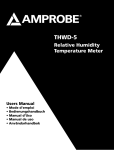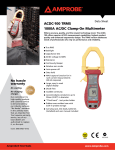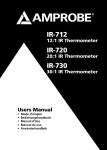Download CT-326-C - Test Equipment Depot
Transcript
CT-326-C Current Tracer Users Manual Current Tracer Users Manual P/N 2757388 Rev 002 11/2013, 6001572 A © 2013 Amprobe Test Tools. All rights reserved. English CT-326-C Limited Warranty and Limitation of Liability Your Amprobe product will be free from defects in material and workmanship for one year from the date of purchase unless local laws require otherwise. This warranty does not cover fuses, disposable batteries or damage from accident, neglect, misuse, alteration, contamination, or abnormal conditions of operation or handling. Resellers are not authorized to extend any other warranty on the behalf of Amprobe. To obtain service during the warranty period, return the product with proof of purchase to an authorized Amprobe Service Center or to an Amprobe dealer or distributor. See Repair Section for details. THIS WARRANTY IS YOUR ONLY REMEDY. ALL OTHER WARRANTIES - WHETHER EXPRESS, IMPLIED OR STATUTORY - INCLUDING IMPLIED WARRANTIES OF FITNESS FOR A PARTICULAR PURPOSE OR MERCHANTABILITY, ARE HEREBY DISCLAIMED. MANUFACTURER SHALL NOT BE LIABLE FOR ANY SPECIAL, INDIRECT, INCIDENTAL OR CONSEQUENTIAL DAMAGES OR LOSSES, ARISING FROM ANY CAUSE OR THEORY. Since some states or countries do not allow the exclusion or limitation of an implied warranty or of incidental or consequential damages, this limitation of liability may not apply to you. Repair All Amprobe returned for warranty or non-warranty repair or for calibration should be accompanied by the following: your name, company’s name, address, telephone number, and proof of purchase. Additionally, please include a brief description of the problem or the service requested and include the test leads with the meter. Non-warranty repair or replacement charges should be remitted in the form of a check, a money order, credit card with expiration date, or a purchase order made payable to Amprobe. In-warranty Repairs and Replacement – All Countries Please read the warranty statement and check your battery before requesting repair. During the warranty period, any defective test tool can be returned to your Amprobe distributor for an exchange for the same or like product. Please check the “Where to Buy” section on www. Amprobe.com for a list of distributors near you. Additionally, in the United States and Canada, in-warranty repair and replacement units can also be sent to an Amprobe Service Center (see address below). Non-warranty Repairs and Replacement – United States and Canada Non-warranty repairs in the United States and Canada should be sent to an Amprobe Service Center. Call Amprobe or inquire at your point of purchase for current repair and replacement rates. USA: Canada: AmprobeAmprobe Everett, WA 98203 Mississauga, ON L4Z 1X9 Tel: 877-AMPROBE (267-7623) Tel: 905-890-7600 Non-warranty Repairs and Replacement – Europe European non-warranty units can be replaced by your Amprobe distributor for a nominal charge. Please check the “Where to Buy” section on www.Amprobe.eu for a list of distributors near you. Amprobe Europe* Beha-Amprobe In den Engematten 14 79286 Glottertal, Germany Tel.: +49 (0) 7684 8009 - 0 www.Amprobe.eu *(Correspondence only – no repair or replacement available from this address. European customers please contact your distributor.) 1 P26 Receiver 1) Probe tip 2 2) LED bar-graph indicator 3 3) Battery status check 4) Range switch 5) ON test mode: Push and hold to test 4 6) Battery test: Push and hold to check battery status 6 5 7) Earphone jack 8) Battery compartment R R 7 8 2 1 T300 Transmitter 1) LED indicator 2) Fuse compartment 3) Pigtail and power cord adapter R R 3 3 CT-326-C Current Tracer Contents SYMBOLS...................................................................................................................... 5 INTRODUCTION............................................................................................................ 5 SYMBOLS AND WARNINGS.......................................................................................... 5 UNPACKING AND INSPECTION.................................................................................... 6 COMPONENTS DESCRIPTION....................................................................................... 6 T300 (6-300 V) Transmitter...................................................................................... 6 P26 Receiver............................................................................................................. 6 OPERATION................................................................................................................... 7 Transmitter Test Position......................................................................................... 7 Receiver Sensitivity.................................................................................................. 7 Distance from wire for half scale reading approximate....................................... 8 Receiver Test Position.............................................................................................. 8 Circuit Breakers, Fuses............................................................................................. 9 Neutral Lines within a Breaker Panel................................................................... 10 Phases, Main Breakers, Transformers, Switch Gear. 300 V Max.......................... 10 Wires in Floors, Walls, Ceilings............................................................................. 11 Conduit.................................................................................................................. 12 Underground Wires and Buried Cables................................................................ 13 Underground Wire, Buried Cables Using an Independent Power Supply......... 13 Neutral Wires and Ground Wires......................................................................... 14 Open Breakers....................................................................................................... 14 Wire to Wire Shorts............................................................................................... 15 Shorts to Ground................................................................................................... 15 Computer Coax Gables.......................................................................................... 15 Transmitter Fuse Replacement.............................................................................. 16 Receiver Battery Replacement.............................................................................. 16 Troubleshooting the Current Tracer..................................................................... 17 SPECIFICATIONS.......................................................................................................... 17 4 Symbols � � � � Refer to the manual Alternating current � � � � � Conforms to relevant Australian standards. � Complies with EU directives � Do not dispose of this product as unsorted municipal waste. � Underwriters Laboratories. � Application around and removal from hazardous live conductors is permitted Battery Double insulated Direct current Dangerous voltage Earth ground Audible tone Introduction The Amprobe PASAR Current Tracer is a hand-held circuit tracing device for locating and tracing circuit breakers and “hot” and neutral conductors without turning off power or interrupting sensitive electronic equipment. The current tracer consists of a transmitter and a receiver for tracing 6-300 V circuits, ac or dc. The transmitter, when connected to a power source, draws short bursts of high frequency current (0.25 amp peak load at 6.25 KHz) from the power line 71 times per minute. The receiver detects the resulting magnetic field surrounding the conductors that supply power to the transmitter. With custom digital filtering, the receiver visually and audibly indicates which circuit is carrying the transmitter’s low ampere, high frequency load. There are no distance limitations with the current tracer since it works by drawing a small load current from the power source and not by injecting an RF signal. Furthermore, this keeps the current tracer’s signal confined to the circuit to which it is applied instead of “bleeding off’ onto other circuits. Therefore, the signal will travel from the transmitter to the source of power (the power generating station) and back on the neutral, totally unaffected by distance. It’s quick, easy and safe to use! �� WARNINGS AND PRECAUTIONS 1. To avoid possible electrical shock or personal injury, follow these instructions and use the tester only as specified in this manual. 2. Read this manual in its entirety before proceeding with any testing. 3. This equipment should only be used by trained professionals who are familiar with electrical hazards. 4. Wear lineman gloves, safety glasses, and protective clothing at all times. 5. Before using any electrical instrument, it should be checked to make certain it is operating properly. 6. In many instances, you will be working with dangerous levels of voltages and/or current, therefore, it is important that you avoid direct contact with any uninsulated, current carrying surfaces. Appropriate insulated gloves and PPE clothing should be worn. 5 7. Before attaching any of the conductors, make sure the voltage presence is not beyond the range of the instrument. 8. When not in use, keep the instruments in their carrying case. 9. If the CT-326-C will not be used for a period of time, remove the battery to prevent leakage in the instrument. Unpacking and inspection 1 x P26 Receiver 1 x T300 Transmitter 1 x Pigtail connector: PT26 1 x Power cord (T300): PC-326 1 x Adapter: AD-1 1 x Earphone, 3.5mm: EP1001 1 x Fuse, ¼ amp, 250V, Fast acting: 3AG-312.250 1 x Soft carrying case: CC-326 ComponentS Description T300 (6-300 V) Transmitter �CAUTION: Do not connect the transmitter to a separate ground in electrically susceptible patient areas of a health care facility. �CAUTION: Make the ground connection first and disconnect it last when using the pigtail connector. The T300 Transmitter is designed for tracing 6-300 V ac or dc circuits by drawing a high frequency load currents from a power source, thus creating a traceable magnetic field around the conductors supplying its power (see Fig. 2). The transmitter houses a crystal controlled digital circuit that never needs adjusting, and will not interfere with sensitive electronic equipment on the line. Transmitter Signal When properly connected to the circuit to be traced, the red LED on the fuse end of the transmitter blinks at a steady rate of 71 times per minute. This indicates that the transmitter is operating, and that there is power on the line. P26 Receiver The P26 Receiver is a tuned magnetic field strength meter. When waved over conductors or circuit breakers, the sensor in the receiver’s tip ignores other line current fluctuations and identifies the conductors feeding power to the transmitter. The probe provides both audible and visible indications when it’s within range of the wires or circuit breakers supplying power to the transmitter. The audio indication is a 3.125 KHz tone. The visual indication is provided by a 10- position LED display. An earphone is included for use with the probe when background noise makes the audio indication difficult to hear. 6 Operation Transmitter Test Position IMPORTANT: For locating and tracing applications, always use a voltmeter to determine the line voltage before connecting the transmitter. 1. Plug the transmitter into any standard electrical outlet (see Fig.1). If there is no outlet available, use the pigtail connector provided. 2. Verify that the transmitter’s red LED is blinking. 3. If the LED is not blinking, confirm whether or not the outlet is energized with a voltmeter. The transmitter must be able to draw current in order to operate. Fig.1 4. If the LED is not blinking and the outlet has been confirmed to be energized, remove the Transmitter from the outlet and check the fuse located on the LED end of the transmitter. The transmitter may have an open fuse if it has been attached to voltages higher than its range. Receiver Sensitivity Strong Signal Weak Signal R 2. Position of the range switch: If the probe displays 10 LEDs, the gain is too sensitive (except in the test position). Turn the range switch to a lower setting. 3. Battery: Change the probe’s battery if the battery test does not cause the LEDs to light within the “Battery OK” area. R 1. Angle of the receiver: The receiver’s tip must be held perpendicular to the conductor in order to allow the conductor’s magnetic field and the receiver’s sensor to couple most effectively. R R The receiver’s range switch determines the probe’s gain - receiver sensitivity depends on three elements: Receiver probe's tip must be perpendicular to the wire Fig.2 7 RANGE SWITCH APPLICATIONS WIRES (most selective) Locate conductor in bundles and conductors entering a breaker switch BREAKERS Locate individual circuit breaker switches and test position SCAN Locate conductors in floors, walls, ceilings, and conduit and correct breaker panels LONG RANGE (most sensitive) Locate underground cables and wire to wire shorts Receiver Range and Applications P26 Receiver Gain Using Looped Wire Test Setup Distance from wire for half scale reading approximate Range Setting in/ft cm/m Relative Gain 1 Wires 1.5 in 3.8 cm X1 2 Wires 2.5 in 6.4 cm X2 3 Breakers 4.0 in 10.2 cm X3 4 Breakers 6.0 in 15.2 cm X5 5 Breakers 10.0 in 26.7 cm X10 6 Scan 18.0 in 45.7 cm X25 7 Scan 2.5 ft. 0.8 m X50 8 Scan 3.8 ft. 1.1 m X90 9 Scan 6.0 ft. 1.8 m X160 10 Scan 7.5 ft. 2.3 m X240 11 Long Range 11.0 ft. 3.3 m X450 12 Long Range 13.0 ft. 3.9 m X850 8 Receiver Test Position 1. To test the receiver’s battery, push the “Battery Test” button. If the LED display does not light up within the “Battery OK” area, replace the battery and repeat. 2. Turn the receiver’s range switch to “Breakers-5.” 3. Press “ON” and wait 2 seconds for the receiver to calibrate. Holding the calibrated receiver, touch its tip to the front and center of the operating transmitter (see Fig. 1). Ten LEDs will flash brightly, in sequence from left to right, at the same rate as the transmitter’s LED, indicating that the receiver is working correctly. This flashing LED response from the probe is what you will be looking for as you trace circuits. Circuit Breakers, Fuses 1. Plug the transmitter into an outlet, or attach with the insulated clip leads of the pigtail connector to the conductors you want to identify. 2. Turn the receiver’s range switch to “scan-5.” 3. Press the receiver’s “ON” button and wait for it to calibrate 4. Wave the receiver’s tip slowly outside the closed panel box door and observe the receiver’s signal. As the probe approaches the correct panel box, the audio indication becomes louder and the LEDs will flash. Use the receiver’s earphone, If necessary, to hear the signal. 5. The correct panel box produces the strongest signal. Not all LEDs need to flash in order to signal the correct panel. However, if the probe’s signal is of equal intensity on more than one panel, the gain may be set too high. Turn the range switch to a lower setting, I.e., “Breakers-3.” 6. Open the panel box door. 7. Turn the receiver’s range switch to “Breakers-4.” 8. Press the receiver’s “ON” button and wait for it to calibrate. 9. Touch the receiver’s tip to each circuit breaker as shown in Fig.3 10.The receiver’s tip must be held at the correct angle to the breaker to ensure accuracy. As the receiver approaches the correct breaker, the audible indicator becomes louder and the LEDs will flash. 11.The breaker controlling the circuit being traced produces the strongest signal. Not all LEDs need to flash in order to signal the correct breaker. However, if the receiver’s signal is of equal intensity on more than one breaker, the gain may be set too high. Turn the range switch to a lower setting, i.e., “Breakers-3” or “Wires-2.” 12.Remove the panel trim. 13.Turn the receiver’s range switch to “Wires-1.” 14.Press the receiver’s “ON” button and wait for it to calibrate. 15.Touch the receiver’s tip on the wire connected to breaker previously identified. The receiver’s tip must be held at the correct angle to the wire to ensure accuracy. Only the wires that the transmitter is attached to will produce a signal. 9 Fig.3 Correct the angle of the probe for accurate readings Neutral Lines within a Breaker Panel Neutral lines may also be traced since the magnetic signal produced by the transmitter returns on the circuit’s neutral line. Follow steps 1-15 16.With the panel trim removed and the receiver’s range switch set on “Wires-1,” touch the receiver’s tip to the neutral wires in the breaker panel. The receiver will indicate only on the neutral of the circuit to which the Transmitter is attached. Phases, Main Breakers, Transformers, Switch Gear. 300 V Max. Since the Transmitter signal is current drawn from the power line, it will travel from the transmitter to the source of power and back on the circuit’s “hot” and neutral lines, totally unaffected by distance. Therefore, the receiver will be able to detect the phase that bears the circuit to which the transmitter is attached, i.e., the remote main breaker, the utility box, the transformer, the switch gear, etc. These do not have to be in the same building or on the same floor as the location of the circuit where the transmitter is attached. As the transmitter’s signal passes through transformers, it is affected only by the step-up or step-down ratio of the transformer. For example, if the signal passes through a 2:1 step-down transformer, the signal will be reduced by one half. When tracing the path of the circuit through transformers, it may be necessary to set the receiver’s range switch to a “Long Range” position. Fig.4 10 Wires in Floors, Walls, Ceilings IMPORTANT: Since the load current on the conductors supplying power to the transmitter flows in opposite directions on the “hot” and neutral wires, the magnetic field surrounding these conductors radiates in the opposite direction. (See Fig. 6). Therefore, when the “hot” and neutral wires are within close proximity, they tend to cancel the force of each other’s magnetic field. For this reason, it is advisable to separate the current paths in order to trace them. The easiest and most effective way to do this is to use a separate ground, not adjacent to the ground of the circuit being traced, to provide a current path back to the power source. 1. Plug the pigtail connector into the transmitter 2. Attach one of the pigtail connector’s insulated clip leads to a separate ground, such as a water pipe (see Fig. 5). As an alternative, use the neutral wire from another circuit away from the circuit being traced. 3. Attach the other lead to the “hot” conductor of the circuit you wish to trace. The transmitter’s LED will blink to indicate it is operating and that the circuit is complete. 4. Turn the receiver’s range switch to “Scan-8.” 5. Press the receiver’s “ON” button and wait for it to calibrate. 6. Hold the receiver’s tip close to the floor, wall, or ceiling where you suspect the conductor is located. 7. Sweep the receiver across large areas until the receiver’s signal locates the conductor. Narrow down the location of the conductor by changing the angle of the receiver and adjusting the range switch as necessary. I I Fig.5 Separate ground connection Fig.6 Direction of load current on conductors NOTE: Be sure to follow the “hot” conductor and not the ground path or neutral wire used to supply power to the transmitter. 11 Individual Wires within Bundles When tracing wires bundled together, it may be necessary to separate them to reduce magnetic coupling to nearby wires (see p.12). Conduit 1. Plug the pigtail connector into the transmitter. 2. Attach one of the pigtail connector’s insulated clip leads to a separate ground such as a water pipe. Be sure the ground path you choose is not adjacent to the conduit you wish to trace. 3. Attach the other lead to the “hot” conductor that runs inside the conduit you wish to trace. The transmitter’s LED will blink to indicate it is operating and that the circuit is complete. 4. Turn the receiver’s range switch to “Scan-6.” Since conduit will frequently cause the signal to become weaker, turn the receiver’s range switch to a higher gain as necessary. 5. Press the receiver’s “ON” button and wait for it to calibrate 6. Hold the receiver’s tip close to the location where you suspect the conduit runs. 7. Sweep the receiver across large areas until its signal locates the conduit. Narrow down the location of the conduit by adjusting the range switch (see Figs. 7) and changing the angle of the receiver. Fig.7 Receiver distance from circuit breaker panel when tracing conduit NOTE: Be sure you are following the “hot” conductor within the conduit and not the ground path or neutral wire used to complete the circuit. Do not use the conduit if you wish to trace for the ground connection. Since the feeder panel may radiate the magnetic field to the nearby conduit, make sure the probe is always used more than 5 feet (1.5 meters) away from the circuit breaker panel during this application (see Fig.7). 12 Underground Wires and Buried Cables 1. Plug the pigtail connector into the transmitter. 2. Attach one of the pigtail connector’s insulated clip leads to a separate ground such as a metal rod planted in the earth. 3. Attach the other lead to the “hot” conductor of the circuit you wish to trace. The transmitter’s LED will blink to indicate it is operating and that the circuit is complete. 4. Turn the receiver’s range switch to “Scan-12.” 5. Push the receiver’s “ON” button and Walt for it to calibrate. 6. Hold the receiver over the surface and walk in the area where you suspect the conductor is located (see Fig.8). If this is unknown, walking a large arc in the suspected area while keeping in mind the orientation of the receiver’s tip to the conductor. 7. Once a signal has been detected, follow it until the maximum reading of LEDs is found. Narrow down the location of the conductor by changing the angle of the receiver and adjusting the range switch as necessary. Remember that the probe’s signal will vary as the conductor’s depth varies. The conductor will be located where you have the strongest indication. 8. Repeat this procedure from the opposite end of the conductor to insure the correct location. NOTE: Be sure you are following the cable you wish to trace and not the ground path used to complete the circuit. Fig.8 Underground Wire, Buried Cables Using an Independent Power Supply �WARNING! - To use this method the conductor must not be energized. 1. Plug the pigtail connector into the transmitter. 2. Attach one of the pigtail connector’s insulated clip leads to a separate ground such as a metal rod planted in the earth. If the optional wire loop is used, a separate ground is not needed. 3. Attach the other lead to a power source, i.e. a battery pack. Connect the power supply to the conductor you wish to trace. 4. Turn the receiver’s range switch to “Wires-1” 13 5. Press the probe’s “ON” button and wait for it to calibrate. 6. Place the tip of the receiver to the grounded side of the transmitter. The receiver should indicate a full scale reading of 10 LEDs. If the receiver does not indicate this, the voltage that is being applied will have to be increased or total resistance of the circuit will have to be reduced. NOTE: Soil has minimal effect on the magnetic field created by the T300 transmitter. However, the signal will be reduced by as much as 50% when the return path is through ground due to the cancellation effect of the return signal. Typically, more voltage will be needed for dry soil and/or longer conductor lengths. Refer to the application notes of the CT-326-C to find the voltage that must be applied to the transmitter to overcome the effects of resistance and Inductance of the circuit to develop acceptable signal strength. Neutral Wires and Ground Wires 1. Plug the pigtail connector into the transmitter. 2. Attach one of the pigtail connector’s insulated clip leads to the circuit’s neutral or ground. 3. Attach the other lead to a grounded 9 V battery (see Fig.9) as an alternative, clip the other lead to the “hot” side of any grounded 6-300 V power source. For example, an extension cord that is plugged into an energized outlet works well. 4. The transmitter’s LEDs will blink if the neutral wire is connected at the panel allowing the circuit to be traced. 5. Trace the neutral or ground wires with the receiver as explained in “Wires in Floors, Walls, Ceilings and Conduits.” NOTE: Be sure to follow the neutral or ground wire and not the “hot” conductor from the circuit used to supply power to the transmitter. Open Breakers 1. Attach the transmitter and use the probe to trace the neutral wire on the dead circuit as explained in steps 1-5 for neutral wires, ground wires. 2. When you can see the panel box, discontinue the above method and locate the correct circuit breaker panel and the neutral line within the panel as explained in “Circuit Breakers and Fuses.” 3. Visually locate the neutral’s corresponding “hot” wire and circuit breaker. Use a voltmeter to verify the open breaker. Fig.9 14 Wire to Wire Shorts 1. Use an ohmmeter to locate the shorted pair of conductors. 2. Disconnect the conductors from power. 3. Plug the pigtail connector into the transmitter. 4. Attach one of the pigtail connector’s insulated clip leads to either of the shorted conductors. 5. Attach the other lead to either pole of a 9 volt battery (or other power source). 6. Connect the other pole of the battery to the other shorted conductor. 7. The transmitter’s LED will blink to indicate that it is operating and that current is flowing from the battery, through the Transmitter, and returning on the shorted conductors. 8. Turn the receiver’s range switch to “Long Range-9) 9. Press the receiver’s “ON” button and wait for it to calibrate. 10. Holding the probe’s tip as close to the shorted conductors as possible, move away from the transmitter. Observe the receiver’s LEDs for a dramatic change in signal strength. This will be the location of the short. NOTE: For best results, it may be necessary to remove loads from the shorted circuit. Shorts to Ground 1. Locate the tripped circuit breaker and make sure the switch is in the OFF position. You may be able to locate the tripped breaker by using the methods described in “Open Breakers” 2. lug the pigtail connector into the transmitter. 3. Attach one of the pigtail connector’s insulated clip leads to the shorted power line. 4. Attach the other lead to the “hot” conductor of an adjacent breaker. As an alternative, attach this lead to a grounded 9 volt battery or other power source. 5. The transmitter’s LED will blink to indicate it is operating and that current is flowing from the adjacent breaker or power source through the transmitter, using the shorted line as a neutral, and going to ground where the short occurs. 6. Turn the receiver’s range switch to “Scan-6.’ 7. Press the receiver’s “ON” button and wait for it to calibrate 8. Holding the receiver’s tip close to the shorted wire, move away from the transmitter. Observe the receiver’s LEDs for signal strength. Computer Coax Gables 1. Plug the pigtail connector into the transmitter. 2. Attach one of the pigtail connector’s insulated clip leads to the shield of the coax cable. 3. Attach the other lead to a grounded 9 volt battery. 15 4. The transmitter’s LED will blink to indicate that it is operating and that the circuit is complete (see Fig. 10). It is not necessary to disconnect the coax cable for this application. If the coax is connected, signal will travel toward ground in both directions and the strength will be reduced by one half. 5. Adjust the receiver’s range switch as necessary; depending on access to the cable during the search. 6. Press the receiver’s “ON” button and wait for it to calibrate. 7. Trace the coax cable with the receiver as explained in “Wires in Floors, Walls, and Ceilings.” NOTE: Make sure the coax shield is grounded at the distant end. Check with the computer operator before disconnecting active computer cables. Fig.10 Transmitter Fuse Replacement Disconnect Instrument from power before replacing the fuse. Use a flat blade screwdriver to turn the fuse cap 1/4 turn counterclockwise. The fuse carrier and the fuse will pop out. Remove the fuse and replace it with the same type of 0.25 amp, 250 V normal blow fuse. (An extra fuse has been provided in the carrying case.) Push the fuse and the fuse carrier back into the transmitter using the screwdriver, and turn the cap clockwise until it locks. Receiver Battery Replacement The battery in the receiver should be tested before each use. To test the battery, push the “Battery Test” button. The LED readout should light up within the “Battery OK” section of the display. If it does not, replace the battery. To replace the battery, hold the receiver face down and push the battery compartment door catch upward with your thumb; the battery cover should pop up exposing the battery. To remove the battery, strike the back of the receiver sharply in the palm of your hand. The replacement battery can then be inserted. Use a 9 V alkaline battery only. DO NOT FORCE THE BATTERY. Observe the picture of the battery in the compartment as a guide to insert the battery correctly. Replace the battery door and be sure to perform the battery test procedure after the new battery is installed. 16 Troubleshooting the Current Tracer To test the operation of the transmitter, connect it to a known power source from 6 to 300 V ac/ dc. The LED should begin to blink at a steady rate of approximately 71 times per minute. If it does not blink, checks to ensure that there is proper voltage on the line and replace the fuse, if necessary. If the LED still does not blink after checking the voltage and the fuse, send the transmitter In for repair. Select “Breakers-5” and hold the receiver’s tip to the front and center of the transmitter. Push the “ON” button and wait 2 seconds for the probe to calibrate. After calibration, 10 LEDs should flash from left to right in sync with the LED on the transmitter. If it does not, the battery may be low. After replacing the battery and the LEDs still do not flash, send the probe in for repair. Specifications Operating frequency: 6.25 kHz Operating temperature: 0°F to 120°F (-18°C to 49°C) Storage temperature: -40°F to 150°F (-40°C to 66°C) T300 Transmitter fuse: ¼ amp, 250V, fast acting (5x20mm) Case operating voltage: Flame resistant ABS plastic 6-300 V ac/dc Operating frequency: 6.25 kHz Line frequency range: dc to 1 kHz Maximum load: 200 mA peak at 110 V Duty cycle: .164 second every .82 second P26 Receiver Power: 9 V Alkaline battery IEC #6LR61 Battery life: 100 hours (typical) Case: Flame resistant ABS plastic 50/60 Hz Rejection: -156 dB to 20K amps @ 50/60 Hz Accessories and replacement parts Pigtail connector: PT26 Power Cord (T300): PC-326 Adapter: AD-1 Earphone, 3.5mm: EP1001 Fuse, ¼ amp, 250V, Fast Acting: 3AG-312.250 Carrying case: CC-326 17 Visit www.Amprobe.com for • • • • Catalog Application notes Product specifications User manuals Amprobe® www.Amprobe.com [email protected] Everett, WA 98203 Tel: 877-AMPROBE (267-7623) Amprobe® Europe Beha-Amprobe In den Engematten 14 79286 Glottertal, Germany Tel.: +49 (0) 7684 8009 - 0 Please Recycle





































